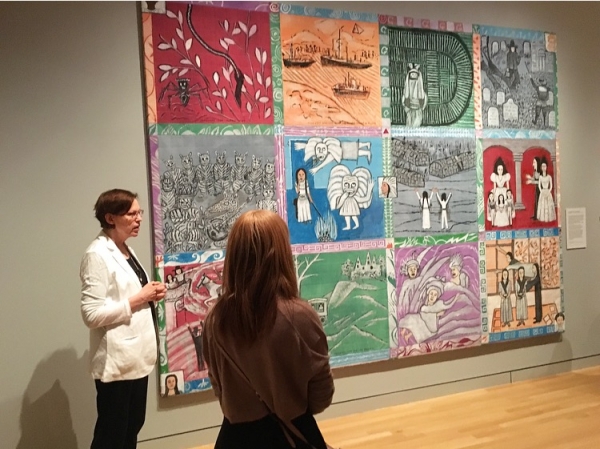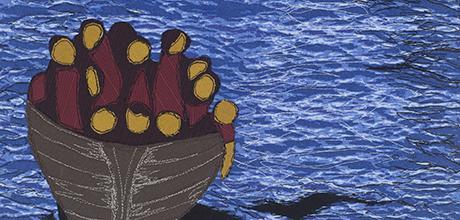The WLP/IA&C visited the Textile Museum's exhibit "Stories of Migration: Contemporary Artists Interpret Diaspora". These personal and universal stories of migration represent an amazing range of experiences, and the recent crises that have driven refugees across the Mediterranean makes the museum topic more salient. We were very lucky to meet with Rebecca Stevens, curator for the show, who shared stories about the artists' creative intentions and the overall exhibit design. See two of our student entries below.
“The George Washington University Textile Museum’s exhibit concerning migrations has never been so relevant; countries at war or in serious poverty have had massive amounts of people emigrating to start new lives.
Using textiles to show the process of migration unifies all the pieces in the show, as well as the stories behind the pieces, textiles are pieces of fabric that are woven together to create something more beautiful. These new textiles represent our country, the United States, along with every other country in the world. All countries are made up of immigrants; the human race started in central Africa and slowly expanded. So like a textile, out countries are made of different people groups (like small fabrics), that are constructed to make something bigger and more beautiful than before.
When I think of migration I think of the colonial days when the British created colonies in America and more recently the Syrian refugees or other refugees that lived in war lands. But, this exhibit reminded me that migration is everywhere. I was especially reminded of the African migration, the middle passage especially. These textiles were some of my favorites: the culture and emotion sewn into these textiles is inspiring from an artist’s point of view. Even the works that featured blank faces sent a powerful message: the subjects in these textiles could be anyone and that so many people died without a name or identity.
I thought that I would relate more to the Holocaust textiles, because I lost all of my European relatives to the concentration camps and the atrocious actions committed there. But for some reason, I didn’t connect as well as I did to the slavery pieces. Perhaps it is because I don’t know any of my ancestors, so my connection to the Holocaust is lost.
Finally, I especially enjoyed the multiple textiles that reflected on the internment camps. Throughout school, history books only gave a sentence or two about these camps. So it was a pleasant surprise to see multiple textiles and wall space dedicated to show what history books cannot; these tapestries show the wrongdoings to the US government. It is so brace for the GW Textile Museum to show these tapestries because the government has hid this ‘secret’ for a long time and it is still a taboo thing to talk about. But for museums to fight this secrecy by dedicating so much space to the internment camps is a step in the right direction.”
-Lindsey Siff
"Today, we went to the George Washington University Textile Museum and visited Stories of Migration - Contemporary Artist Interpret Diaspora, exhibit. I attended Jewish Day School my entire life, so the concept of a people immigrating to a new land for a better life is a tale as old as time. For centuries, the Jews have constantly been persecuted and exiled; the most horrific and prominent example is World War II, the Holocaust. The piece that stood out to me the most today was the Wailing Wall in Krakow, Poland. During the war, the Nazis destroyed the Polish Jews’ cemeteries and the jagged stones later became known as the Wailing Wall.
During the second semester of my senior year of high school, I was lucky enough to study abroad for three months in Poland and Israel. We spent a week in Poland visiting concentration camps and taking our studies of the Holocaust to a whole new level. After twelve years of day school, it was jarring to see the horrific pictures from our textbooks come to life; when you see ovens that were built for people, it's not an image you soon forget.
Despite having studied it for so many years, the Holocaust is still a difficult subject for me. My throat always tightens when I hear stories or see pictures because several members of my family were killed by the Nazis. I almost didn’t go abroad because of it and I didn't think I wanted to study in Poland, anyway. I had heard that the food was awful, the country itself was ugly and there were horrible memories everywhere. However, by the end of our time in Poland, I had a whole new perspective.
After visiting Treblinka, Majdanek and Auschwitz, three of the deadliest camps, I saw just how well the Nazis preserved their death camps, but that also made me realize that the Jews, my people, have preserved their memories just as well, if not even better. Additionally, there's a budding sense of hope throughout the country, as they try to re-build what was one of the most flourishing Jewish communities in the world, Kraków, and that's pretty inspiring. If a destroyed city can slowly re-build itself from scratch, imagine what we could do in our already existing and thriving communities back home. As members of the Women’s Leadership Program, it is our job to spearhead these actions. I know that I will do everything in my power to ensure that history never repeats itself and that the Holocaust never happens again. This is what I’m passionate about. Leaders channel their passions into action that inspires other to do the same. Alone, I could be effective. Together, with my fellow cohort members, nothing is impossible.
I think the 'Stories of Migration' exhibit as a whole is so vitally important because the world needs to hear these stories. When people hear and see heart wrenching pictures and stories, it moves them to action, but art is subjective; everybody thinks about it in different ways. In the words of Ossie Davis, “art is a serious tool, indispensable for arriving at our humanity; art tells us what can be.” If we trust our instinct, we can make a big difference."
- Hannah Sessler
"Ethiopia is a rich country not in money but rather for its diverse cultures, people, languages, love, and traditions. However, today Ethiopia is also a corrupt political country, currently run by people who are politically-bankrupt and who do not hold the best values for the country. I come from a place where running is the only way out, I was born in a country where The First Human Being was found but I was also forced to leave my country. Being an immigrant to another country sometimes isn't a choice, sometimes it's a choice between life or death. Walking in the desert for days without food and water is sometimes the only way to truly pursue one’s life.
Through art, and especially this exhibit, I learned that truly risking one's life for the benefit of the next generation is one option for pursuing peace and enriching the idea of coming together for a better life. Although there isn't such a thing as living free once one leaves the place they've called home. This image instills in me the idea of forgiving and being grateful because no matter what I have been though there is always someone who has suffered more. The idea of forgiving someone in order to make my life better and in order to give the best life to the coming generation is truly what I have learned from this exhibit."
- Bontu Kumsa






